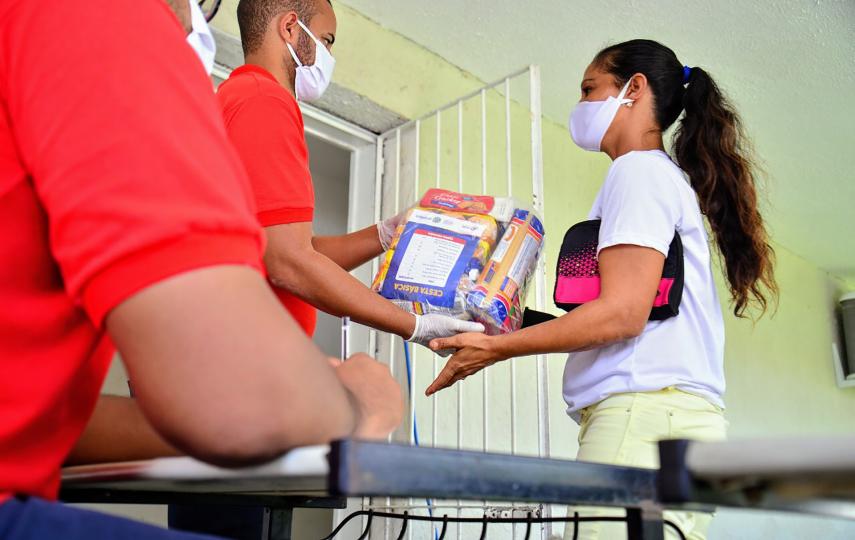There is a moment at the start of every major crisis when you think: “This is going to change everything.” COVID-19 was no exception.
“In humanitarian response, there will be a ‘before’ and ‘after’ COVID-19,” Ed Schenkenberg van Mierop, executive director of the think tank HERE-Geneva, wrote in late March.
But as the crisis born of this global pandemic has evolved, some of the promises of deep transformation in a humanitarian aid sector that has long resisted reform have proven overly optimistic – at least so far.
Here are 13 ways the pandemic may change the future of humanitarianism – and the forces of resistance that may get in the way.
Jump to chapters:
Share your thoughts here.
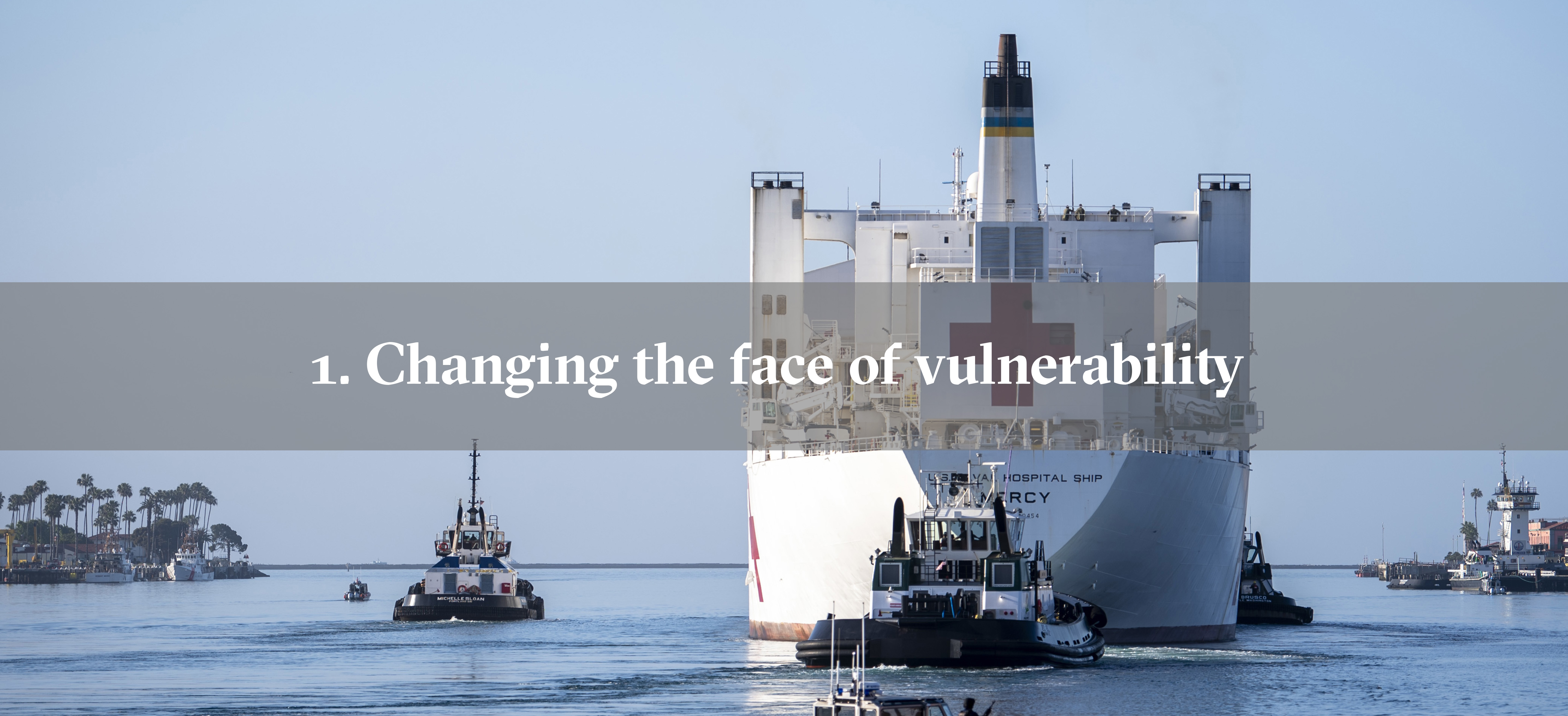
The hospital ship USNS Mercy in Los Angeles on 15 May. (US Navy)
Modern international humanitarianism, with its roots in the 1968 famine in Biafra, was built on the concept – to put it crudely – of the rich in the West helping poor, dark-skinned people on the other side of the world.
So what happens when the rich themselves need help? Or when “Southern” countries face less fallout and the epicentre of a crisis is in places like the United States and Europe? Or when the crisis is more mismanaged in countries like the UK and the United States than in South Africa and Turkey?
“What if some African governments are doing a better job than our own of managing the coronavirus?” American journalist Jina Moore asked in a piece called What African Nations Are Teaching the West About Fighting the Coronavirus.
Hopes for change: In one sense, this crisis puts the whole enterprise of humanitarianism into question. “The age of top-down saviours is well and truly over,” writes Aarathi Krishnan, a strategy consultant who advises humanitarian organisations. There may be less willingness in future to entertain foreigners coming into “Third World” countries with their Western solutions.
“The age of top-down saviours is well and truly over.”
Even pre-COVID-19, human rights organisations had begun turning their sights on the United States. But now, aid organisations like Médecins Sans Frontières have launched emergency operations in countries like Canada, Switzerland, and Italy (not without fierce debate internally); and some international aid workers have returned home to support their own countries.
“The eco-system will change,” Sisira Madurapperuma, director of preparedness and resilient recovery at the Asian Disaster Preparedness Centre, told TNH. “It’s no longer South-South cooperation or North-South cooperation. It’s South-North-South cooperation,” with countries exchanging help based on their particular expertise.
The fact that humanitarian crises increasingly occur in middle-income countries may lead to a review of the coordination of aid, argues Raphael Gorgeu, head of analysis, positioning, and advocacy at MSF.
And as humanitarian aid becomes less dominated by the West, and diverse voices display confidence that they too have knowledge to offer, humanitarianism will necessarily be re-shaped in the conception of those new players.
As Gorgeu says, the mostly Western concept of the aid sector was already put into question pre-COVID-19, but the pandemic will likely lead to continued loss of traction for the traditional, classical, or “Dunanist” approach to humanitarianism, in line with the vision of Henry Dunant, who founded the International Committee of the Red Cross.
But keep in mind: While many have touted the power of the pandemic as an “equaliser”, the Inter-Agency Research and Analysis Network (IARAN), a humanitarian collective that studies the future of the sector, predicted in its scenario planning at the end of April that COVID-19 could lead to “new forms of neocolonialism”, whereby “the North-South power structure which permeated international aid is exacerbated”, due to developing countries suffering the greater eventual fallout from the pandemic.

With many traditional donor countries redirecting trillions of dollars towards propping up their economies, and governments generally under pressure to “help their own” before helping those abroad, financial analysts expect a big hit to Official Development Assistance (ODA) in the year(s) to come, especially for those countries that peg their ODA to a percentage of GDP.
Development Initiatives describes as “within the range of possibilities” a sharp drop in ODA of $25 billion by 2021, including from some of the biggest donors. That would be 15 percent of a total ODA flow of $165 billion in 2018. The impacts of the pandemic on global resource flows are already being felt, it says, with investors pulling out approximately $90 billion from emerging markets in March 2020 alone.
In addition, as rates of unemployment skyrocket around the world, individual giving is also likely to decrease. A survey by Bond, a network of UK international charities, found that international NGOs in the UK risked losing one third of their total income due to a reduction in individual giving.
Signs of change: In the short term, this will threaten many programmes and the survival of many non-profits: according to the survey, 86 percent of UK charities are cutting back or considering cutting back overseas programmes.
The most obvious example of this so far is Oxfam International’s decision to lay off 1,450 staff and withdraw from 18 countries in the wake of the financial pressures of the pandemic (though there are other motivations, too).
“Some smaller or less visible organisations are going to be wiped out because of lack of funding,” Caroline Abu’Sada, general director of SOS Mediterranée Switzerland, said in a webinar at the end of April.
In the long term, this may force a change in the way the sector funds itself.
“Some smaller or less visible organisations are going to be wiped out because of lack of funding.”
“We have known for years that it is not sustainable to rely on institutional funding,” Rebecca Petras, adviser to H2H, a network of specialist organisations that helps the humanitarian sector perform better, told TNH in mid-April, referring to grants from governments and foundations. Many international NGOs rely on institutional funding for most of their income. “But I believe this crisis will accelerate the decline in this business model,” Petras said.
Antonio Donini, former head of policy at the UN’s emergency aid coordination body, OCHA, and co-founder of United Against Inhumanity, a movement against the violation of human rights, sees this business model as “part and parcel of the neo-liberal agenda”, functioning “as a top-down conveyor belt for Western policies, ideas, values… Is this model sustainable in the post-pandemic era?” he wrote.
But keep in mind: After the economic crisis of 2008, ODA did not drop. The Organisation for Economic Co-operation and Development says it sees no indication of any decreases so far, and the largest providers of aid have said they will strive to protect ODA budgets.
In fact, large donors have pledged hundreds of millions of dollars for the humanitarian response to COVID-19. (Though it’s unclear whether this is additional funding or “whether we are again robbing Peter to pay Paul when there’s a big spike in demand,” Lydia Poole, an independent analyst of humanitarian financing, told TNH.)
To date, the UN humanitarian appeals have raised more than $1.14 billion since March, and some charities have seen record-breaking successes in their COVID-19 fundraising campaigns.
“I really thought we were going into a very dark tunnel. The contrary happened,” said Tineke Ceelen, director of the Dutch foundation Stichting Vluchteling, which gets much of its funding from the public. “They started donating as I have never seen before.”
Some aid agencies are also seeing more direct engagement from the private sector and philanthropic sources, suggesting the potential for more diversified donor pools in the wake of this crisis.

At first, it seemed this pandemic might shake up the oligarchy of big aid agencies that control most of the humanitarian response industry.
The thought was that those aid organisations agile enough to adapt to drastically different ways of working would be more likely to survive this crisis.
“Nimbleness wins,” Petras said. “The loser will be the ‘traditional’ very large and operational international NGO. The model is simply inefficient in too many ways.”
“Big heavy organisations are going to find it hard to pivot and they’re going to be expensive to run,” added Christina Bennett, CEO of the Start Network. “The future is not about institutions. It’s about networks, coalitions, and devolution of decision-making.”
Few signs of change: Two months in, the opposite seems to be true.
Even if they are not agile by nature, the big behemoths have largely managed to continue their operations. Over the last two months, key decisions have been navigated by a “small club”, with the World Health Organisation, the World Food Programme, and the World Bank “consolidating their roles of leader and coordinator” of the traditional international humanitarian system, as Gorgeu put it. “The quest for a new vaccine positions organisations such as GAVI (the global vaccines alliance) at the front and centre of the game.”
And big institutions have continued to receive most of the funding.
“In the short term, it seems like this crisis has actually reinforced the centrifugal pull of the multilateral system, at least in terms of where to spend money in a hurry,” Poole said.
“In the short term, it seems like this crisis has actually reinforced the centrifugal pull of the multilateral system, at least in terms of where to spend money in a hurry.”
“Because the suspected impact of COVID in the most fragile countries will be to add macro-economic shock on top of the rest, the multilateral system remains pretty much in first line here,” added Cyprien Fabre, acting head of the crises and fragility team at the OECD’s Development Cooperation Directorate.
“The bottom line is that large incumbents seem best positioned to weather this storm,” Raj Kumar, the CEO of Devex, wrote, because they are the only organisations that have the financial reserves and “fat to cut” to withstand the short-term economic shock. Smaller organisations won’t have the same cushion.
Keep in mind: Medium-sized international NGOs may be the ultimate losers: they are not necessarily big enough to weather the storm but not local enough to be effective in this pandemic.
And as this crisis kills off smaller NGOs, consolidation and mergers are likely – leading to more big institutions.

Countries have turned inward, fighting amongst each other over ventilators and blaming each other for the spread of the virus. Multilateral channels, like the EU or the UN Security Council, have not been heavily tapped in responding to this crisis. The WHO has taken largely unjustified blame for the crisis, but has certainly shown its limits.
“One thing which distinguishes the reaction to this pandemic compared to the financial crisis of 2008/9,” Guy Ryder, director-general of the International Labour Organisation, told the BBC, “is that back then, the international community really did step up to provide a global response to the global problem. Unfortunately, that’s much less the case this time around.”
“The crisis has brought to our eyes even more clearly the dearth of global cooperation,” said Sara Pantuliano, executive director of the Overseas Development Institute. While multilateral organisations continue to monopolise the humanitarian response, “there is no leadership globally to make the [broader] system work as it should. The UN development system is nowhere to be seen – at least not at the level required.”
For Donini, there’s a clear reason for this. “The major challenges humanity faces today – climate crisis, unregulated financial capitalism, growing inequality within and among societies, international crime, the arms trade, acts of terror, the inhumanity of protracted warfare, the rise of surveillance states… and of course, pandemics…These challenges are transnational at their core. Multilateralism was not conceived as a tool to deal with transnationality.”
Hopes for change: Most past changes in the international order followed major crises. As multilateralism dies, could something better emerge from its wake? For instance, could this pandemic be the turning point needed for a new world order, in line with former UK Prime Minister Gordon Brown’s call for a new global government?
Could this pandemic be the turning point needed for a new world order?
“Conventional wisdom has it that only world wars have the capacity to trigger enough political will for reforming the international system. Will the pandemic have a similar effect? Could we envisage that the UN shifts away from ‘We the states’ towards ‘We the peoples’?” Donini asks.
But keep in mind: This narrative about multilateralism assumes this crisis could lead to something better. What if the alternative is worse?
The death of multilateralism has long been lamented and, to date, nothing has taken its place. What if it simply leaves a void or a vacuum, with states becoming more interventionist and protectionist?
“Personally,” says TNH Senior Editor Ben Parker, “I think COVID-19 is likely to lead to a new Dark Age of semi-permanent war, protectionism, xenophobia, yawning inequality, and festering hatred. What would be the future of humanitarianism then?”
Protectionist states will be harder for humanitarians to penetrate and xenophobia will only make their jobs more complex. Already, activists warn the pandemic has led to a shrinking space for civil society.
Lockdown measures have brought human rights abuses too: Nigerian, Kenyan, and Ugandan police officers have been accused of beating or killing people to enforce COVID-19 restrictions, and five Rwandan soldiers are facing court-martial on charges of assault, robbery, and rape during nighttime patrols.
In addition, many governments have used COVID-19 as an excuse to row back on their asylum policies, in violation of international law. "The effects of this virus are the greatest threat to the international human rights regime, in particular the protection of asylum seekers, that we've seen in 70 years,” Gillian Triggs, assistant high commissioner for protection at the UN’s refugee agency, UNHCR, said in a webinar.
In short, the pandemic has cemented the central role of government, Gorgeu argues, with “stability, political, and security agendas taking over… In such settings, the space for principled [humanitarian] action, aligned with human rights frameworks and independent from broader political and security consideration, will become even more challenging.”
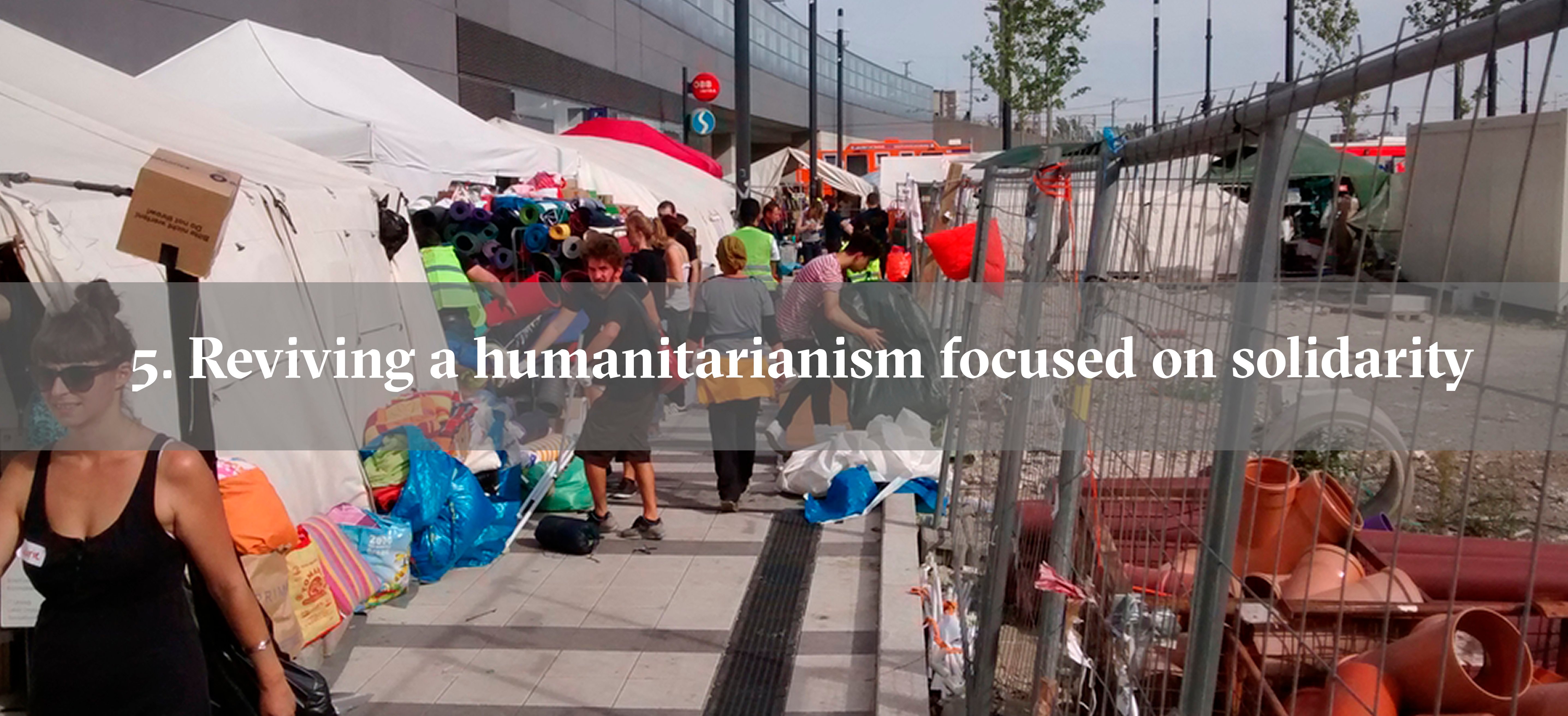
Vienna's Train of Hope, a self-organised initiative to aid migrants, in 2015. (Paul Currion/TNH)
In recent years, the rise of what we at TNH call “new humanitarians” has seen people who are not professional aid workers increasingly play a role in solving the world’s problems.
COVID-19 is likely to accelerate this trend.
Signs of change: As countries have turned inward, many citizens are doing the opposite: reaching out to their neighbours and communities to help in a practice now termed “mutual aid”.
Similarly, many businesses are discovering a newfound altruism, shifting to producing protective equipment, vaccines, or even shoes for medical workers.
As countries have turned inward, many citizens are doing the opposite: reaching out to their neighbours and communities.
This trend could encourage more “everyday humanitarianism” in the future, and incentivise the humanitarian response system to adapt to a networked global society with people power at its centre.
For instance, could we imagine Airbnb-style or networked humanitarianism, whereby specific needs can be matched by scouring the internet for available responses in a more bespoke and local way, a model arguably better suited for the future?
Perhaps, more fundamentally, this resurgence of the volunteerism spirit that used to be at the core of the humanitarian enterprise is a reminder of what has been lost as the sector professionalised.
“Before annual reports and pay scales and business plans and bureaucratic processes, we were passionate, inspired volunteer activists who were connecting and empowering and talking about things like solidarity,” Danny Sriskandarajah, then head of the civil society network CIVICUS (now chief executive of Oxfam GB), told a conference in 2018. “That’s where our pulsing heart was.”
This crisis challenges where humanitarians put their energies and the role they see for themselves in society. At a time when inequality, abuse, predatory economics, and conflict cause so much need, the apolitical framing of humanitarianism is coming into question.
Julie Billaud, professor at the Graduate Institute of International and Development Studies in Geneva, argues that humanitarians should stop offering technical solutions, such as food, water, and shelter, and instead start pushing within the political sphere for greater public well-being, solidarity, and social justice.
The apolitical framing of humanitarianism is coming into question.
As Gorgeu notes: “The space for international humanitarian action may find a new life in alternative forms of international solidarity and increased activist action.”
But keep in mind: An explosion of self-organised volunteerism in the wake of the refugee crisis in Europe – with private citizens pulling asylum seekers out of boats and hosting them in their homes – was at the time thought to have forced a rethink. Similarly, in the early days of the Syrian conflict, local networks of underground volunteers played a central role in distributing aid. In both cases, the formal humanitarian aid structure struggled to leverage these networks and neither led to radical change in the way the traditional aid architecture operates.
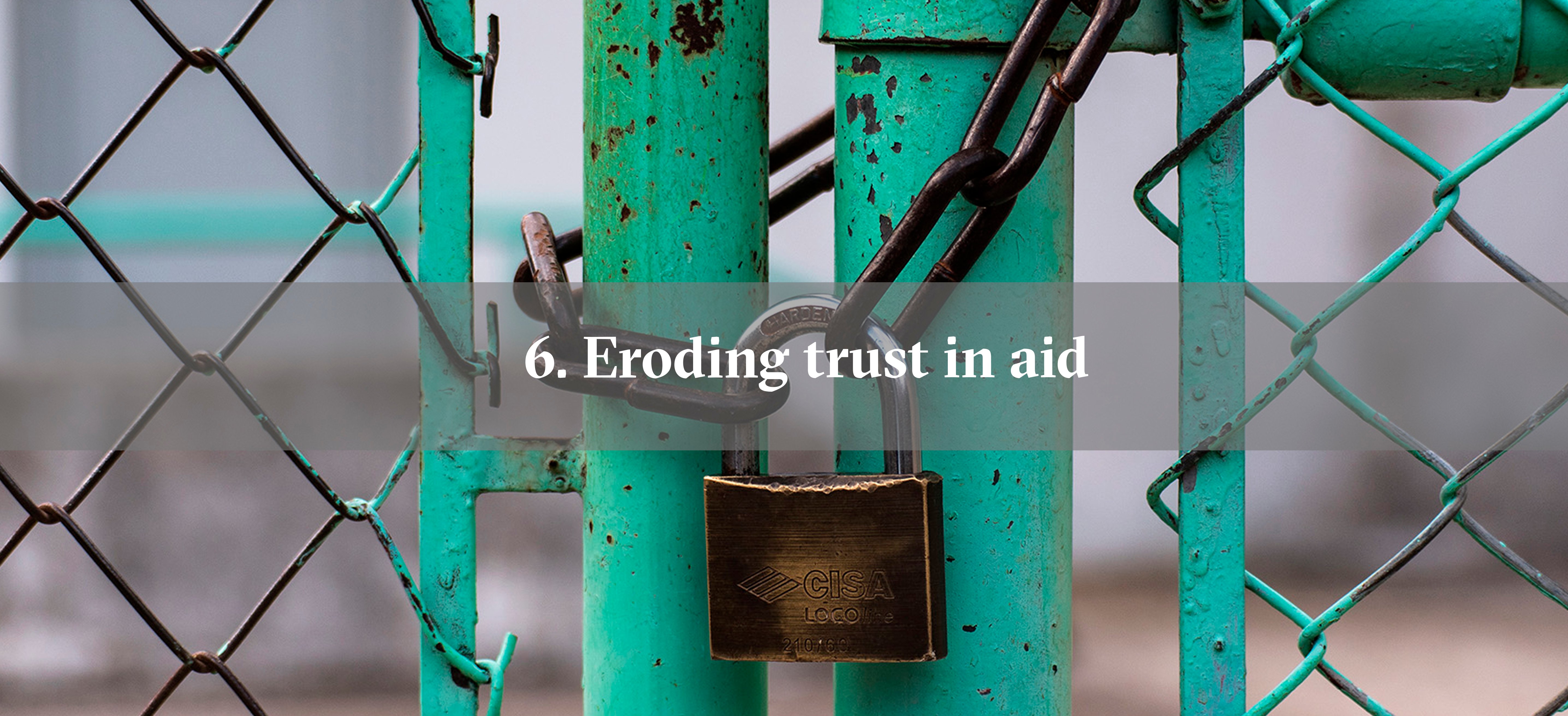
Trust in Northern NGOs dipped in 2018, after a sex abuse scandal involving Oxfam became public, revealing a sector-wide #MeToo problem. But had been slowly creeping back up, according to Edelman’s Trust Barometer. COVID-19 could drag trust in international aid back downwards.
In some countries, aid workers have been alleged to be prime vectors of the disease; in others, decisions to redirect existing aid programmes – including food distributions – towards COVID-19 response have provoked conspiracy theories over alleged corruption and the political agendas of aid agencies.
But perhaps most of all, as Petras put it, this crisis will fuel distrust because “when the going got tough, humanitarians up and left – because they could.”
This crisis will fuel distrust because “when the going got tough, humanitarians up and left – because they could.”
Hajir Maalim, regional director for the Horn and Eastern Africa at Action Against Hunger, told TNH he was frustrated that in places with fragile systems, where governments most need additional support, humanitarian organisations are recalling their staff just when they most need to scale up to avert an "unthinkable human catastrophe".
The recent withdrawal of half of the UN’s remaining staff in Yemen is an example, with a senior UN official noting that the morale of the UN’s Yemeni workforce “will take a hit with colleagues gone… It’s going to leave the national staff feeling very fragile.”
But keep in mind: Several local aid workers interviewed by TNH said they hadn’t seen significant backlash against expat aid workers. That’s because in a context of restricted movement and limited access, international aid systems are “irrelevant”, said Carlos Mejia, executive director of Oxfam Colombia.
Most delivery is done by local organisations anyway, he and others said. International NGOs are often so nationalised that their programmes continue running even if some international staff leave. And affected people don’t distinguish between which agencies are providing the relief.
As Sema Genel Karaosmanoğlu, who runs the Turkish NGO Support to Life, put it: “I think that perspective is very much from a Global North perspective – seeing themselves really big.”
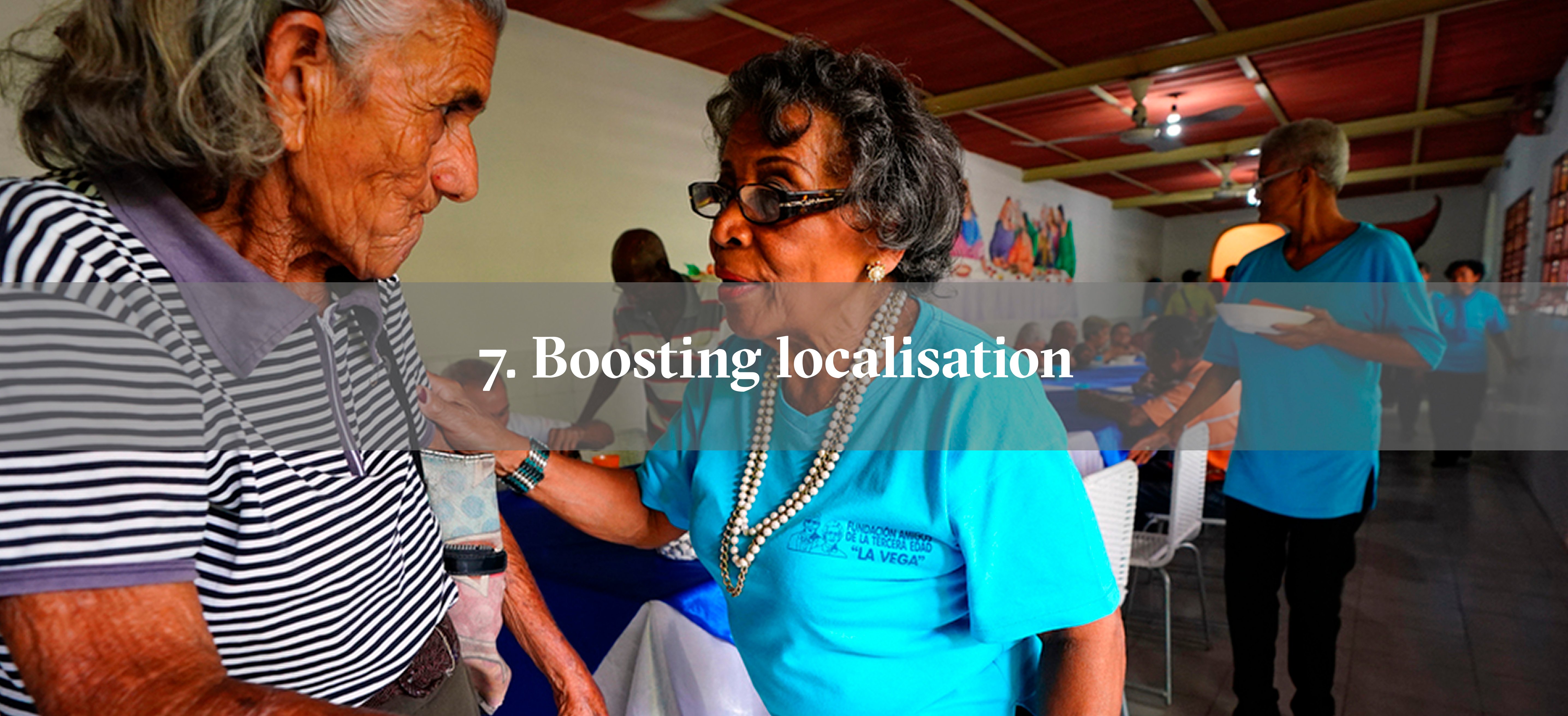
Carmen Senovia Tovar, 77, works with a local NGO to serve lunch to elderly people at a public kitchen in Caracas, Venezuela. (Susan Schulman/TNH)
As international aid workers returned to deal with crises in their own countries, aid agencies removed staff from high-risk environments out of a duty of care, and restrictions on movement challenged international aid in many places. It seemed likely that the localisation of aid delivery would become the single biggest change this pandemic would spawn in the sector, a final deliverance of this long-awaited reform agenda.
Hopes for change: “This pandemic, and in particular the related travel ban, will be used as evidence that the notion of ‘overseas aid’ is increasingly outdated, inefficient, and ineffective, if not unethical,” Schenkenberg wrote.
Hugo Slim, former head of policy at the International Committee of the Red Cross and co-founder of the Oxford Consortium for Human Rights, concurred. “It is often said that the great plague that hit Europe in the 14th century did a lot to abolish feudalism in many ways,” he said, in yet another webinar. “Maybe we’ll see the rise of new structures, new forms which really challenge traditional formal structures.”
And for Jeremy Konyndyk, senior research fellow at the Centre for Global Development, who previously led the Office for US Foreign Disaster Assistance, if localisation delivers on COVID-19 – likely to be a defining crisis for this aid era – “it will be hard to revert to the status quo ante afterward.”
But keep in mind: From the beginning, some were circumspect that any momentum towards greater localisation would lead to long-lasting change. Jules Frost, of the CHS Alliance, feared any progress was “not because the right decisions have been made for the right reasons”.
In one of its COVID-19 scenarios, the foresighting group IARAN predicted that without “principled and effective partnering strategies in place” – a euphemism for the often transactional relationships between typically richer Northern NGOs and their local counterparts in affected countries – the power dynamics within the humanitarian sector would not significantly change in the long term.
Mejia said that while the lesson of this crisis has been that local humanitarian leadership is the only way forward, the role of locals has remained “invisible, as always”, and international NGOs still have the same attitude that they know best.
Genel Karaosmanoğlu, who is also the chair of the NEAR Network of Southern-led NGOs, said the pandemic has indeed mobilised local responders, but in a kind of “parallel process” distinct from the formal humanitarian response, which has largely continued its operations as usual.
“There is definitely localisation going on, but it’s not what the humanitarian system understands as localisation,” she said. “It’s about local capacities doing something for themselves. These are not the capacities that would necessarily apply for humanitarian funding…
“And as long as people are allowed to start travelling again, I have the feeling that things will pretty much go back to normal,” Genel Karaosmanoğlu said. “I don’t really foresee a major change in the way the system works.”
Nor have funding flows followed the ambition of empowering local responders, even amid a crisis when they are clearly well placed to respond.
“I don’t really foresee a major change in the way the system works.”
As the NGO consortium ICVA pointed out, the first Global Humanitarian Response Plan for COVID-19 allocated most funding to UN agencies, meaning NGOs were essentially left out of the major appeal. And, according to an analysis by Charter for Change of UN Financial Tracking System data in early May, just 0.1 percent of total funding reported for COVID-19 response has gone directly to national and local NGOs.
“I haven’t seen any particular push for supporting local NGOs and, frankly, I don’t expect it,” Fabre, of the OECD, said. “Managing small NGO contracts requires a lot of staff to process and manage small disbursements. Now that all staff in administration is mobilised toward C-19 response, there is not much leeway for small local organisations, or at least not more than before.”
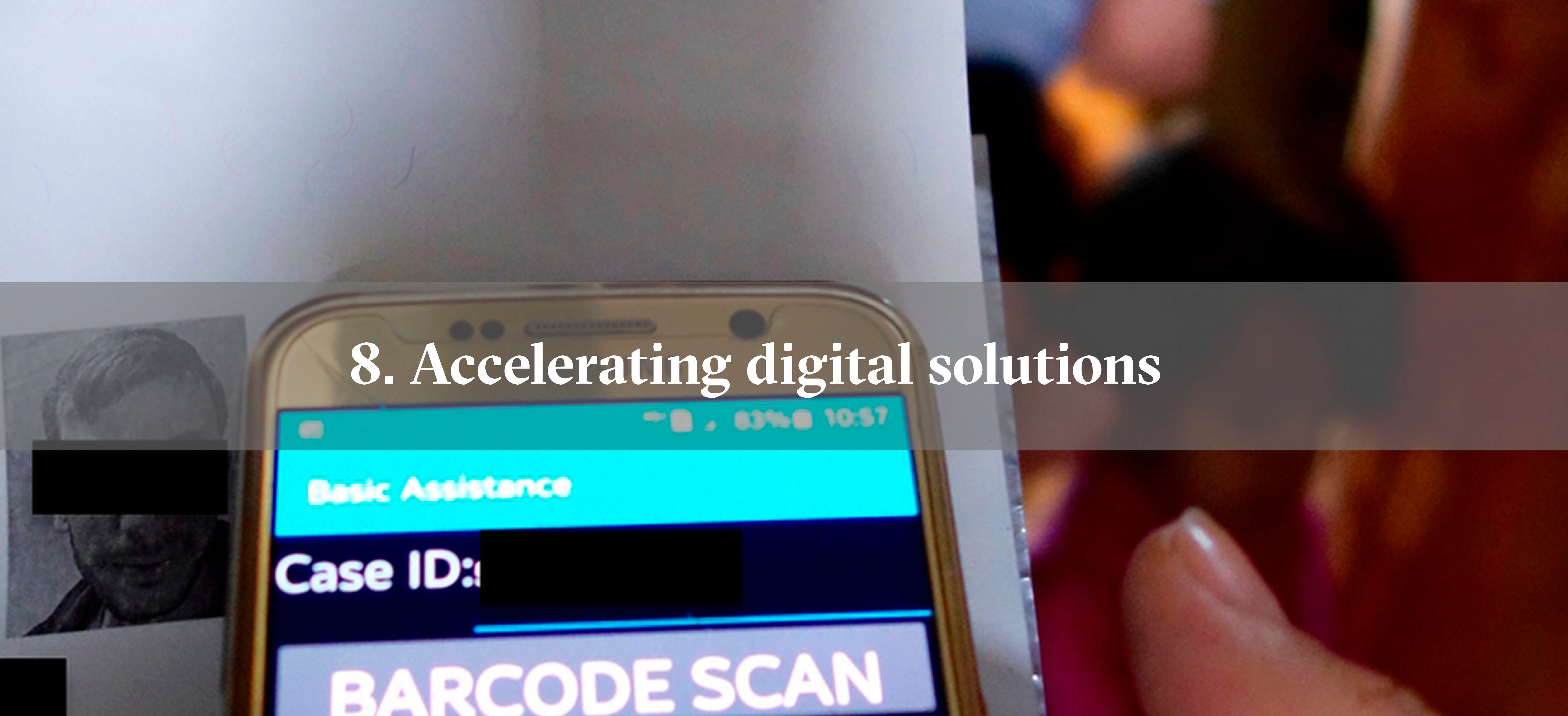
Some expected this moment to lead to a new form of “cyber-humanitarianism” or “Amazon-like humanitarian assistance”.
“The humanitarian sector has not enjoyed the benefits of the digital revolution, and this is our opportunity to embrace it,” the former UK foreign secretary and current president of the International Rescue Committee, David Miliband, told TNH.
But with the exception of a few drones delivering COVID-19 test samples in parts of Africa – seen by some as more of a PR stunt than anything else – this crisis hasn’t threatened to unveil any wholescale technological revolution.
Signs of change: Perhaps the most notable change to date has been a significant expansion in cash delivery, not only by aid agencies but also by governments. More than 190 countries have expanded social welfare programmes – including unemployment pay, grants, cash top-ups, and poverty safety nets. A World Bank researcher, Ugo Gentilini, estimated that cash transfer programmes now account for half of all safety net interventions by governments.
Aid agencies have also made forays into distance learning, with “child-friendly spaces” moved onto Zoom, and WhatsApp used to teach classes or to distribute videos about the risks.
As everywhere, the number of webinars in the sector has skyrocketed, with major conferences like the World Bank’s Fragility Forum and the Stockholm Peace and Development Forum going virtual. Some local NGOs have discovered more effective and efficient ways of working together online and are reviewing their travel and training policies in the recognition that “we don’t necessarily all need to be in the same room to do some of these things,” Genel Karaosmanoğlu said. (Others, to be sure, can’t afford Zoom licences.)
Oxfam Colombia has taken a more radical approach, planning to swap its physical headquarters in the capital Bogotá for a smaller, "lighter", more flexible work space. “The pandemic taught us that we can be virtual,” Mejia said. “Let’s break everything and re-start differently.”
“Let’s break everything and re-start differently.”
But keep in mind: It’s still unclear whether these small beginnings will lead to a more dramatic re-examining of the operating model for humanitarian aid.
Even if localisation doesn’t become a full reality, for Petras, of H2H, this crisis should force a rethink of expensive headquarters and staff flying around the world, in line with many private sector companies that have discovered the power of remote working.
“The international community is used to parachuting into a single event,” said Mejia. “The pandemic is affecting every single place in the world. There is no parachute for such a long crisis. We need to think differently.”

Beyond modalities of delivery, this crisis has prompted some humanitarians to ask themselves deeper questions about their place in the world.
“This is a sudden-onset crisis, where the solutions are not entirely humanitarian,” says the Start Network’s Bennett. “Our solutions represent a sliver of what the world needs right now. It needs economic support, debt relief, welfare systems, rights, prison reform. It needs so many things… We are a bit player in all of this.”
Otherwise put, many of the challenges the pandemic poses are linked to structural weaknesses that cannot be easily addressed by humanitarians.
The pandemic has cemented the centrality of government, not only because it is in many cases best positioned to provide large-scale social welfare programmes, but also because of additional emergency powers.
What’s more, according to some estimates, formal international aid may make up as little as three percent of resource flows to countries experiencing humanitarian crises.
Read more → Coronavirus emergency aid funding
And as development and financial institutions get more involved in settings traditionally reserved for humanitarians, COVID-19 has illustrated that the definitions of what is “humanitarian” and what is “development” are arbitrary at best, making the so-called humanitarian-development nexus either a no-brainer or irrelevant.
“There is no delineation anymore, and not even any delineation of funding anymore – no more humanitarian and development. It’s all COVID-19,” Bennett said.
In any case, the UN’s Global Humanitarian Response Plan, budgeted at $6.7 billion across all UN agencies and partner NGOs, looks tiny compared to the International Monetary Fund’s $100 billion increase for lending to low-income and emerging markets, or the World Bank’s $160 billion in financing (loans and grants) to address the health and socio-economic impacts of the pandemic.
So in the face of a crisis of this magnitude, where do humanitarian organisations fit?
Hopes for change: For many, the answer lies in more networked ways of working, in which humanitarian agencies establish partnerships with development institutions, private companies, local communities, and new philanthropists – those who have the skills, scale, access, supply chains, and the sustainable business models that humanitarians don’t.
In short, this crisis forces the sector to be more humble. Or, as IARAN put it, humanitarians can “embrace a backseat”.
Humanitarians can “embrace a backseat”.
Keep in mind: Depending on how you see things, humanitarians have for years either been “stretched” or pursued mandate creep – growing into areas like education, livelihoods, and other non-lifesaving needs.
Any drop of funding will likely force a narrowing of focus on only basic lifesaving activity — more crudely described as “trimming the fat”.
This could lead the sector towards the “back-to-basics” approach that some have been calling for, in which humanitarians focus on what they do best: saving lives among the most marginalised in the most difficult areas.
According to Bennett, “seeing what our position is within that bigger picture – and operating on that basis – is something we don’t always do.”

The pandemic has exposed the consequences of poor or insufficient safety nets, in both developed and developing countries.
“Even the richest countries in the world are discovering that hubris, privatisation, and the de-funding of welfare state services, including health in particular, have put them in a fix that is, potentially, costing millions of lives,” Donini wrote.
As Miliband put it, this crisis has made clear that “the holes in the global safety net are a threat to healthcare everywhere. We are paying the price of neglect. That neglect is something we should call attention to and challenge its peripheral place in the global conversation.”
Hopes for change: Momentum is growing for calls for universal basic income, universal access to healthcare, and investments in the building of health systems, particularly in less developed countries, to lift up the poorest and most vulnerable in society and make people more resilient to shocks.
“The right response to this crisis would be to revive the social state in the Global North, and to accelerate its development in the Global South,” French economist Thomas Piketty, bestselling author of Capital in the Twenty-First Century, told The Guardian.
But keep in mind: A devastating outbreak of the Ebola virus in 2014 in West Africa prompted similar calls for sustained investment in developing weak healthcare systems around the world.
“The lingering lesson from Ebola is that once the crisis passed, long-term funding for health system strengthening did not really materialise,” said Poole, the financial analyst.
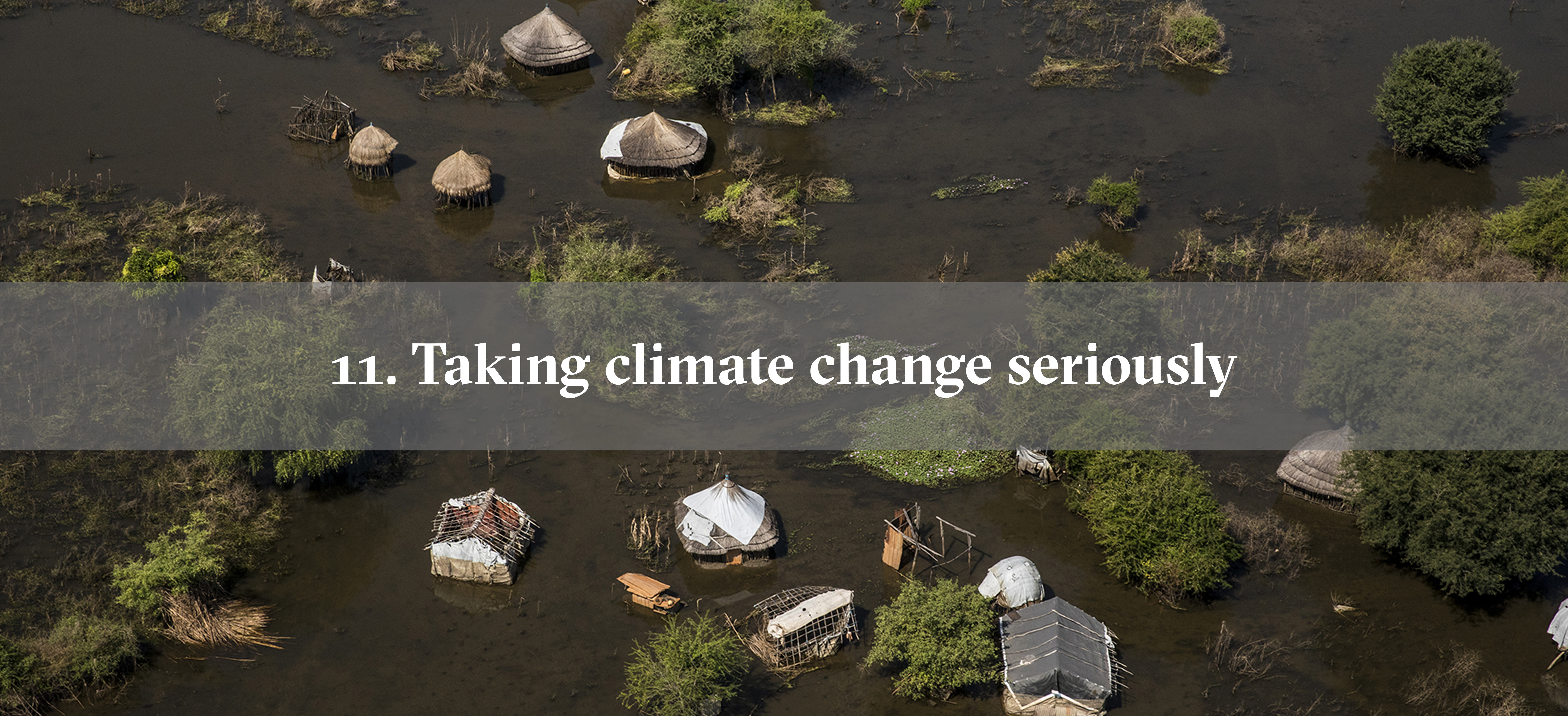
This pandemic has exposed the challenge to the aid sector of a global threat that creates simultaneous needs around the world, exceeding by a long shot humanitarians’ capacity to respond.
But we haven’t seen anything yet.
Hopes for change: Aid agencies have finally woken up to climate change as a major humanitarian threat, but this crisis is likely to push it even higher up the agenda and drive a step-change in how the sector prepares for the coming tidal wave.
“Just like with this pandemic, when it comes to climate change, we are not prepared,” says Guillaume Charron, an advisor to the Marshall Islands, a country in the Pacific at risk of being wiped off the map by climate change. “Humanitarians should consider a world with a lot less money around and overwhelming needs everywhere, not just in developing countries.”
“Just like with this pandemic, when it comes to climate change, we are not prepared.”
Keep in mind: If there’s one silver lining in this pandemic, it is that drastic government measures needed to fight climate change that were once deemed impossible – shutting down air travel, depending less on international supply chains, and putting people’s health before the economy – are in fact possible. (Though of course at a cost that needs to be well managed, with serious reflection given to what an alternative economy can look like.)
If this crisis proves it possible to continue providing humanitarian aid without aid workers flying around the world and driving big polluting 4x4 landcruisers (that’s not to suggest coronavirus hasn’t disrupted aid efforts; it certainly has), perhaps the humanitarian sector will similarly realise that it, too, can reduce its carbon footprint moving forward.

Less paper, more aid was the slogan coined by the NGO consortium ICVA in a 2016 campaign that lobbied donors to be more flexible with their funding and demand less paperwork. This was also a priority area for reform in the Grand Bargain agreement of the same year, building on long-standing demands from grantees for greater flexibility in the restrictions imposed on them to access funding.
Now, in the face of such an usual situation, “donors are really starting to loosen those restrictions on all of us — because they have to,” Bennett said.
Signs of change: Philanthropic foundations, government donors, and UN agencies alike have sent their grantees or partners messages offering “maximum flexibility” and easy ways to adapt their programming, including outputs and timeframes, as required by this unpredictable environment.
“We are working swiftly on easing some of the hurdles resulting from contractual obligations which can prevent flexible responses,” reads a letter from the UN High Commissioner for Refugees to the NGOs to which it sub-contracts funding. To that end, UNHCR has: increased permissible budget line transfers from 20 percent to 30 percent; allowed disbursements of money before reports are cleared; instructed its teams to keep reporting requirements to a minimum; simplified “results chains”; accepted more personnel-related costs; reduced performance verifications; and made it easier to amend their agreements.
OCHA has similarly issued guidance on increased flexibility; and foundations have responded positively to a call by CIVICUS for donors and intermediaries to support necessary shifts in strategy and reprioritisation.
There’s less earmarking too. For instance, according to Poole, Germany, one of the world’s largest humanitarian donors, did not dictate how its 300 million euros in humanitarian funding should be spent, once allocated to several grantees.
“Can this be an opportunity to really think about whether those restrictions are necessary [in the first place] and whether flexibility can really lead to better outcomes for people affected by coronavirus and beyond?” Bennett asks.
But keep in mind: Parts of this flexibility are linked to the very nature of the COVID-19 crisis.
It’s difficult to know how and where to respond in such a global crisis, so earmarking at a country level makes little sense, Poole pointed out.
The crisis may also result in less flexibility, in the sense that all donors begin directing their funding towards COVID-19 alone.
As Gareth Price-Jones, executive secretary of the Steering Committee for Humanitarian Response (SCHR), a grouping of NGOs, told TNH, “if funds are diverted from longer-term programming to immediate needs in a short-sighted way, that worsens both the response to COVID and the response to other underfunded crises.”
Donors have shown they can be more imaginative in the immediate heat of the crisis, yet it’s unclear whether they will reduce the conditions they put on funding in future.
Donors have shown they can be more imaginative in the immediate heat of the crisis.

Studies have long touted the return on investment of spending on prevention and preparedness, with an oft-cited figure that for every $1 spent in disaster risk reduction, $7 is saved in response. But acting early on disasters that are yet to occur has proven to be a tough ask.
Health experts and other leaders had seen this pandemic coming for years – Barack Obama did – and yet many countries did not have the systems in place to deal with it.
“One trend that I hope to see as a result of us dealing with new and uncharted territory here is that we learn to anticipate versus respond,” Bennett said.
Signs of change: After seeing the trajectory of the disease in Asia and Europe, governments in Africa and the Middle East and aid agencies in vulnerable areas were able to anticipate how the virus would hit and how to prevent the worst.
“Countries were shutting down and declaring states of emergency when no or single cases were reported,” John Nkengasong, the director of the Africa Centres for Disease Control and Prevention, told The New Yorker. “We have evidence to show that that helped a lot.”
The humanitarian aid sector kicked into gear too, with a flurry of preparations in refugee camps like Kakuma in Kenya, Rohingya camps in Bangladesh, and fragile areas like Goma in the Democratic Republic of Congo. Much of the Global Humanitarian Response Plan for COVID-19 focused on preparedness, and the controversial Pandemic Emergency Financing Facility, an experiment in public-private risk financing established by the World Bank, finally paid out $195 million for COVID-19.
Schenkenberg sees this as an opportunity for more wide-scale change: “COVID-19 may be the ultimate push to rethink better humanitarian preparedness worldwide.”
“COVID-19 may be the ultimate push to rethink better humanitarian preparedness worldwide.”
In particular, anticipatory approaches have thus far focused primarily on hazards like tropical storms or floods, with insurance payouts triggered automatically based on hydrometeorological data. COVID-19 is generating interest in expanding this kind of model to epidemics and disease outbreaks, where well-developed detection and surveillance systems offer a strong starting point.
The concept is gaining steam, including through a working group established as part of the Risk Informed Early Action Partnership, a grouping of funders and aid agencies seeking to increase anticipatory financing, which is now looking at the intersection between COVID-19 and early action, as well as a new blog series exploring the link between anticipatory approaches and epidemics.
But keep in mind: Despite increased interest in the topic spurred by this crisis, we have not yet seen a major increase in anticipatory humanitarian action overall (even now that the threat of COVID-19 is clear, local NGOs complain they have received little new money to prepare for new outbreaks and are having to reprogram their activities with what they’ve got). There are probably a few reasons for that.
First, early action is more valuable in localised outbreaks, where a disease can be more easily contained. A global pandemic is not the ideal candidate for anticipatory action: payment triggers based on surveillance data are no good if there isn’t enough money or protective equipment to go around.
Second, trigger-based payments also have limitations. For Poole, “they are too specific to cope with reality, they can be costly, and they only apply to a very specific slice of risk — that which can be modelled.”
She added that premium payments and insurance payouts could offset what might normally be covered by humanitarian funding, “but I don’t see it providing a solution for complex and compound risks,” such as when the disease hits an area already affected by locusts, flooding, and conflict, as in parts of the Horn of Africa.
Finally, even if it is more effective than traditional humanitarian response, anticipatory action cannot replace more substantial long-term development.
For more information on how COVID-19 is changing humanitarianism, here are some resources we found interesting:
Blog posts, reports, and articles
- The world tomorrow: COVID-19 and the new humanitarian (Humanitarian Law & Policy blog, 20 May, 2020)
- After COVID-19: Time to reset (HERE-Geneva, 22 March, 2020)
- Post-pandemic change? Humanitarian action and multilateralism in transnational times (United Against Inhumanity, 20 April, 2020)
- For the global development community, COVID-19 poses big questions (Devex, 1 April, 2020)
- COVID-19: ‘We don’t get back to normal because normal was the problem’ (Overseas Development Institute, 1 April, 2020)
- Will coronavirus lead to fairer societies? (The Guardian, 12 May, 2020)
- What mutual aid can do during a pandemic: A radical practice is suddenly getting mainstream attention. Will it change how we help one another? (The New Yorker, 11 May, 2020)
- How COVID-19 can accelerate shifts towards the Grand Bargain commitments (Grand Bargain Secretariat, April 2020)
- Re-Imagining Aid: Applying a fresh COVID tinted lens to a tired critique (Medium, 31 May 2020)
- How is COVID-19 affecting NGOs’ finances and operations? (Bond, 8 April, 2020)
- Not fit for this future (Medium, 6 April, 2020)
- Localisation in the COVID-19 Global Humanitarian Response (ICVA, 30 March, 2020)
- COVID-19 preliminary scenarios for the humanitarian ecosystem (IARAN, April 2020)
- COVID-19 scenarios from a network designed to incubate ideas, shape strategies, and build coalitions (The Long Crisis, May 2020)
- Coronavirus: moins d’humanitaire, plus de politique! (Le Temps, 23 March, 2020 - in French)
Webinars
- COVID-19 and the future humanitarian response (HERE-Geneva, 8 April, 2020)
- Accountability, Ethics & COVID-19 (CHS Alliance, URD and Sphere, 16 April, 2020)
- How will COVID-19 impact crisis zones (The New Humanitarian, 19 March, 2020)
- Sustaining peace in the time of COVID-19 (SIPRI, 13 May, 2020)
- COVID-19: How do we protect the most vulnerable? (Geneva Press Club, 29 April, 2020)
ha/bp/js/ag




